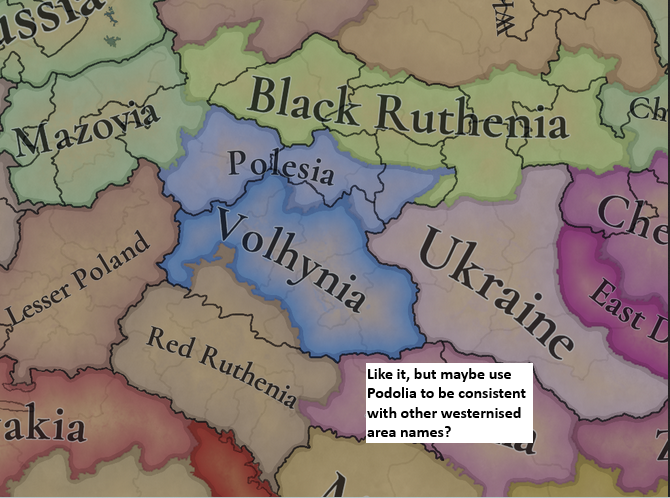I agree with most of your take, these are my comments on this:Hi,
Great work!
I've made a feedback on the original post about this region, but right now I see, that some locations in Estonia are even worse, than they've been before. First of all, some locations are in the wrong place. Other point of critique - some locations could be somewhat relevant at the starting date, in role of some knightly manors in minor villages, or church parishes belonging either to Livonian Order or local bishoprics, but will be completely irrelevant and forgotten later in history.
0. Thank You for not ignoring the Võrtsjärv lake!
1. On the map, Wolde (Valjala) is located nowhere near the place it really located and this north-south divide of Saaremaa seems unnatural. It would be better to divide it diagonally, with North-Eastern part being Wolde and South-Western part being Arensburg and line divide in the centre. But considering the start date, it would be better to add Maasilinna (Sonneburg), owned by the Livonian Order, instead of Valjala, as both Valjala and Kuressaare were owned by the bishopric and not the Order.
2. I am not really sure, what St. Martins means to represent, but I assume that it's based on Martna church parish (Martens, if You prefer German). The thing is, it's nowhere near it's location on the map, and also it would not make any sense to add some kind of local village as a location.
3. Same applies to Saarahof, Gross St. Johannis and Vasknarva. First is merely a manor, second is a small town, and third is a minor castle, which was pretty relevant up until 17th century, they don't really add anything to the map, just filling the free space. There are always better solutions and better used space, than adding random parishes and manors.
4. Again, same point about Wendau. It's in wrong place. And it's a completely irrelevant place, adding nothing.
5. It's hard to see where border between Toolse and Rakvere is located, but it seems that Toolse has moved Rakvere from it's original place. I don't thnik that adding Toolse is required, as it was also a castle and was relevant until the end of Livonian order, but there was nothing of significant afterwards.
6. Keinis (Käina) wasn't mentioned before 1522, and likely didn't exist at the start of the game, as population on island of Hiiumaa was really scarce, even temporary and seasonal in most places, and Grossenhof (Suuremõisa) was more relevant during the middle ages, with it's gothic stone church. But later the most significant settlement would become Kärdla (Kertel) and it would remain the only real town on the island until today, so I would that's more appropriate choice. Either that or Grossenhof.
7. Don't understand why Wolmar got a piece of Southern Estonia, as it has nothing to do with that historically.
8. I am not really see the need of making Tartu and Rotalia their own provinces with such a small number of locations. There were bishoprics, that can be seen as "counties" in simplyfied county-duchy-kingdom rank system, and it could be somewhat reasonable for the Middle Ages and the Livonian order, but would make no sense later down the line, when territory of Livonia was always diveded into provinces of Curonia, Livonia and Estonia. So I believe it's better to use theres historical provinces, not creating new. Province of Livonia could be divided into Northern and Southern parts, as they were culturally different.
My first feedback included the Latvian part of Livonia, but I will not comment on it right now, as I have much less historical knowledge about it.
As I see it, locations must be added according to these principles: they posses significant historical value as a centres of smaller areas, and they were economically or politically important during the duration of the game. According to this, my proposed version of the map, with it's Latvian parts updated by Paparrde is much better at this, as all locations are at least somewhat relevant both at the start of the game, and later. It also respects historical and cultural boundaries between historic provinces and allow for real historic outcomes.
I will also include German and Estonian location names for every location on my version of the map:
- Estland - Nortern Estonia:
Reval, Tallinn
Rappel, Rapla
Padis, Padise
Waissenstein, Paide
Wesenberg, Rakvere
Narwa, Narva
Hapsal, Haapsalu
Leal, Lihula
Kertel, Kärdla- Nord-Livland - Northern part of Livonia (or Southern Estonia) with majority Estonian populace:
Dorpat, Tartu
Oberpahlen, Põltsamaa
Walk, Valga
Neuhausen, Vastseliina
Fellin, Viljandi
Karkus, Karksi
Pernau, Pärnu
Alt-Pernau, Vana-Pärnu
Soneburg, Maasilinna
Arensburg, Kuressaare
- 1: Sonneburg would indeed be a far better (and more historical) option. Wolde/Valjala does indeed seem to be outside of the location.
- 2: The parish of Martens probably already existed, and the area was inhabited (but barely). Seeing how Paradox sometimes uses minor villages in sparsely populated areas, it might be plausible to keep this.
- 3: Same as note #2; Some might be 'necessary', others maybe not. As long as they existed back then.
- 4: It's indeed outside of the location, it seems. Unless map-projection is on a whole other level of difference. It's also a bit anachronistic, true.
- 5: I don't have a strong opinion on those locations, either way. I understand why some low-populated, more rural hamlets and castles are sometimes added.
- 6: Fully agreed.
- 7: No clue, maybe because of some map the developers used?
- 8: Not a strong opinion on this, either.
A very good suggestion. I hope this area gets another quick review because of your comment, as the rest of the region seems to be quite well-made.
- 2
- 1



















